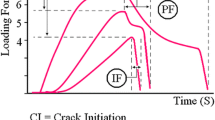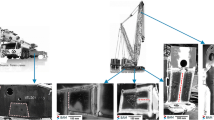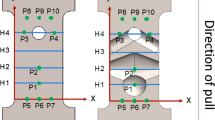Abstract
Failure of resistance spot welds in computer-aided engineering models is based upon criteria that incorporate test data obtained in various loading conditions including different proportions of tensile, shear, and moment loads. The decomposition of the critical load into its respective shear, tensile, and bending moment components is influenced by the rigid body motion during their corresponding mechanical tests. Continuous tracking of the weld orientation and the deformed coupons is required for accurate determination of the load components at the onset of failure. A comprehensive experimental investigation was performed to characterize the critical failure load components in combined loading using various orientations of KS-II tests and a range of coach peel coupon geometries. Mechanical testing was coupled with digital image correlation (DIC) to systematically evaluate empirical force-based failure models for resistance spot welds of two third generation advanced high strength steels with optimal and suboptimal fusion zone diameters. New analysis methodologies using DIC were developed to account for rotation and deformation of the joint in the determination of the shear, normal, and bending moments acting on the spot-welded joints. The coach peel test results for both steels revealed a non-convex experimental fracture locus in bending-tension loading cases. The conventional assumption of a convex failure locus overestimated the critical bending moment strength between 7 and 66%. Results indicated that changes in the operative failure mechanism from pullout/partial-pullout to interfacial can expand the fracture loci within the shear-tensile loading mixities. Improved alternative functional forms for the weld failure models were proposed and contrasted with conventional models that assume convexity.






















Similar content being viewed by others
References
Zielinski J, Andreucci R, Rajagopalan N, Aktas CB (2018) Prospects for meeting the corporate average fuel economy standards in the U.S. Resour Conserv Recycl 136:466–72. https://doi.org/10.1016/j.resconrec.2018.03.026
Keith DR, Houston S, Naumov S (2019) Vehicle fleet turnover and the future of fuel economy. Environ Res Lett 14. https://doi.org/10.1088/1748-9326/aaf4d2
Zhao J, Jiang Z (2018) Thermomechanical processing of advanced high strength steels. Prog Mater Sci 94:174–242. https://doi.org/10.1016/j.pmatsci.2018.01.006
Kalashami AG, Digiovanni C, Razmpoosh MH, Goodwin F, Zhou NY (2020) The effect of silicon content on liquid-metal-embrittlement susceptibility in resistance spot welding of galvanized dual-phase steel.https://doi.org/10.1016/j.jmapro.2020.07.008
Zhang S, Ghatei-Kalashami A, Midawi ARH, Zhou NY (2022) A Comparison between Hardness-Scaling and Ball-Indentation Techniques on Predicting Stress/Strain Distribution and Failure Behavior of Resistance Spot Welded Advanced High Strength Steel. J Manuf Sci Eng Trans ASME 144. https://doi.org/10.1115/1.4053730/1134922
Figueredo B, Ramachandran DC, Macwan A, Biro E (2021) Failure behavior and mechanical properties in the resistance spot welding of quenched and partitioned (Q&P) steels. Weld World 65:2359–2369. https://doi.org/10.1007/s40194-021-01179-z
Pouranvari M, Marashi SPH (2013) Critical review of automotive steels spot welding: Process, structure and properties. Sci Technol Weld Join 18:361–403. https://doi.org/10.1179/1362171813Y.0000000120
Mohamadizadeh A, Biro · E, Worswick M. novel double-half spot weld testing technique for damage progress and failure analysis using digital image correlation techniques 123AD. https://doi.org/10.1007/s11340-021-00743-4
Mohamadizadeh A, Biro E, Worswick M (2022) Failure characterization and meso-scale damage modeling of spot welds in hot-stamped automotive steels using a hardness-mapping approach. Eng Fract Mech 268:108506. https://doi.org/10.1016/j.engfracmech.2022.108506
Ma Y, Takikawa A, Nakanishi J, Doira K, Shimizu T, Lu Y et al (2021) Measurement of local material properties and failure analysis of resistance spot welds of advanced high-strength steel sheets. Mater Des 201. https://doi.org/10.1016/J.MATDES.2021.109505
Ghassemi-Armaki H, Khan Q, Gill AS, Zilincik S (2017) Characterization and modeling of spot-weld joints in press hardening steels associated with softening in heat affected zone. 11th Eur LS-DYNA Conf 1–13
Wung P (2001) A force-based failure criterion for spot weld design. Exp Mech 41(1):107–13. https://doi.org/10.1007/BF02323112
Lin S-H, Pan J, Wu S, Tyan T (2004) Failure loads of spot weld specimens under impact opening and shear loading conditions. Exp Mech 44(2):147–57. https://doi.org/10.1007/BF02428174
Chabok A, Cao H, van der Aa E, Pei Y (2022) New insights into the fracture behavior of advanced high strength steel resistance spot welds. J Mater Process Technol 301:117433. https://doi.org/10.1016/J.JMATPROTEC.2021.117433
Mohamadizadeh A, Biro E, Worswick M (2020) Shear band formation at the fusion boundary and failure behaviour of resistance spot welds in ultra-high-strength hot-stamped steel. Sci Technol Weld Join 25:556–563. https://doi.org/10.1080/13621718.2020.1773057
Sherepenko O, Mohamadizadeh A, Zvorykina A, Worswick M, Biro E, Jüttner S (2021) Determination of resistance spot weld failure path in ultra-high-strength press-hardened steel by control of fusion boundary transient softening. J Mater Sci 56:14287–14297. https://doi.org/10.1007/S10853-021-06165-W/FIGURES/10
Midawi ARH, Shojaee M, Mohamadizadeh A, Bourque C, Ghassemi-Aramki H, Worswick M et al (2022) A novel technique to measure the local mechanical properties of third generation advanced high strength steel resistance spot welds. Forces Mech 9. https://doi.org/10.1016/j.finmec.2022.100150
Shamsujjoha M, Enloe CM, Chuang AC, Coryell JJ, Ghassemi-Armaki H (2021) Mechanisms of paint bake response in resistance spot-welded first and third generation AHSS. Materialia 15:100975. https://doi.org/10.1016/j.mtla.2020.100975
Ma Y, Yu Y, Geng P, Ihara R, Maeda K, Suzuki R et al (2021) Fracture modeling of resistance spot welded ultra-high-strength steel considering the effect of liquid metal embrittlement crack. Mater Des 210. https://doi.org/10.1016/J.MATDES.2021.110075
Ghassemi-Armaki H, Biro E, Sadagopan S (2017) Advanced characterization of HAZ softening of AHSS for crash modeling. ISIJ Int 57:1451–1460. https://doi.org/10.2355/isijinternational.ISIJINT-2016-649
Samadian P, ten Kortenaar L, Omer K, Butcher C, Worswick MJ (2020) Fracture characterization of tailored Usibor® 1500-AS and damage modelling based on a coupled-micromechanical-phenomenological strategy. Eng Fract Mech 223:106785. https://doi.org/10.1016/J.ENGFRACMECH.2019.106785
Tamizi M, Pouranvari M, Movahedi M (2017) Welding metallurgy of martensitic advanced high strength steels during resistance spot welding. Sci Technol Weld Join 22:327–335. https://doi.org/10.1080/13621718.2016.1240979
Wang W, Zhu Q, Liu C, Wei X (2019) An investigation on the resultant-based failure criterion for resistance spot welding joint in crush test. Int J Crashworthiness 24:152–162. https://doi.org/10.1080/13588265.2017.1421012
Livermore Software Technology Corporation (2015) LS-DYNA Keyword User’s Manual - Volume II. r:6581
Pouranvari M, Marashi SPH (2012) Failure of resistance spot welds: Tensile shear versus coach peel loading conditions. Ironmak Steelmak 39:104–111. https://doi.org/10.1179/1743281211Y.0000000066
Hu S, Haselhuhn AS, Ma Y, Li Y, Carlson BE, Lin Z (2021) Influencing mechanism of inherent aluminum oxide film on coach peel performance of baked Al-Steel RSW. Mater Des 197:109250. https://doi.org/10.1016/j.matdes.2020.109250
Xu Z, Tian C, Mao L, Tian H, Yi B, Ling H (2023) A mechanical properties and failure mechanism study for resistance spot welded AHSSs under coach-peel and lap-shear loads. Eng Fract Mech 290:109474. https://doi.org/10.1016/j.engfracmech.2023.109474
Lin SH, Pan J, Tyan T, Prasad P (2003) A general failure criterion for spot welds under combined loading conditions. Int J Solids Struct 40:5539–5564. https://doi.org/10.1016/S0020-7683(03)00341-X
Seeger F, Feucht M, Frank T, Keding B, Haufe A (2005) An investigation on spot weld modelling for crash simulation with LS-DYNA. 4th LS-DYNA Conf, Bamberg, Germany 1–12
Tolton CJ (2020) Characterization of spot weld failure within weld groups under predominantly shear loading, Master’s thesis. University of waterloo
Song JH, Huh H (2011) Failure characterization of spot welds under combined axial–shear loading conditions. Int J Mech Sci 53:513–525. https://doi.org/10.1016/J.IJMECSCI.2011.04.008
Langrand B, Combescure A (2004) Non-linear and failure behaviour of spotwelds: a “global” finite element and experiments in pure and mixed modes I/II. Int J Solids Struct 41:6631–6646. https://doi.org/10.1016/J.IJSOLSTR.2004.06.009
Lin SH, Pan J, Wu SR, Tyan T, Wung P (2001) Failure loads of spot welds under combined opening and shear static loading conditions. Int J Solids Struct 39:19–39. https://doi.org/10.1016/S0020-7683(01)00187-1
Pandya KS, Grolleau V, Roth CC, Mohr D (2020) Fracture response of resistance spot welded dual phase steel sheets: Experiments and modeling. Int J Mech Sci 187:105869. https://doi.org/10.1016/j.ijmecsci.2020.105869
Shojaee M, Tolton C, Midawi ARH, Butcher C, Ghassemi-armaki H, Worswick M (2022) Influence of loading orientation on mechanical properties of spot welds. Int J Mech Sci 224:107327. https://doi.org/10.1016/j.ijmecsci.2022.107327
Yurioka N, Suzuki H, Ohshita S, Saito S (1983) Determination of necessary preheating temperature in steel welding. Weld J 62:147–153
American Welding Society (2012) AWS D8.9M, 3rd edn. - Test method for evaluating the resistance spot welding behavior of automotive sheet steel materials
American Welding Society (2021) AWS D8.1M, 3rd edn. - Specification for automotive weld quality resistance spot welding of steel
Song S, Shojaee M, Midawi ARH, Sherepenko O, Ghassemi-Armaki H, Biro E (2023) Influence of expulsion and heat extraction resulting from changes to electrode force on liquid metal embrittlement during resistance spot welding. J Mater Res Technol 23:1458–1470. https://doi.org/10.1016/J.JMRT.2023.01.093
Khameneh F, Abedini A, Butcher C (2021) Lengthscale effects in optical strain measurement for fracture characterization in simple shear. Int J Fract 232:153–180. https://doi.org/10.1007/s10704-021-00598-9
Anderson D, Butcher C, Pathak N, Worswick MJ (2017) Failure parameter identification and validation for a dual-phase 780 steel sheet. Int J Solids Struct 124:89–107. https://doi.org/10.1016/j.ijsolstr.2017.06.018
Shojaee M, Midawi ARH, Barber B, Ghassemi-Armaki H, Worswick M, Biro E (2021) Mechanical properties and failure behavior of resistance spot welded third-generation advanced high strength steels. J Manuf Process 65:364–372. https://doi.org/10.1016/j.jmapro.2021.03.047
Pawar S, Singh AK, Park K-S, Choi S-H (2023) Effect of welding current on the microstructural evolution and lap-shear performance of resistance spot-welded 340BH steel. https://doi.org/10.1016/j.matchar.2023.113126
Langrand B, Markiewicz E (2010) Strain-rate dependence in spot welds: Non-linear behaviour and failure in pure and combined modes I/II. Int J Impact Eng 37:792–805. https://doi.org/10.1016/J.IJIMPENG.2010.01.004
Chao YJ (2003) Ultimate strength and failure mechanism of resistance spot weld subjected to tensile, shear, or combined tensile/shear loads. J Eng Mater Technol Trans ASME 125:125–132. https://doi.org/10.1115/1.1555648
Betiku OT, Shojaee M, Sherepenko O, Midawi ARH, Chertov AM, Ghassemi-Armaki H et al (2022) Optimizing post-weld performance of press-hardened steel resistance spot welds by controlling fusion zone porosity. Weld World 66:1733–1746. https://doi.org/10.1007/s40194-022-01332-2
Lee Y, Wehner TJ, Lu M, Morrissett T, Pakalnins E (1998) Ultimate strength of resistance spot welds subjected to combined tension and shear. J Test Eval 26:213–9
Seeger F, Michel G, Blanquet M (2008) Investigation of spot weld behavior using detailed modeling technique. 7th LS-DYNA Conf, Bamberg, Germany 29–38
Lim J, Ha J, Oh C (2015) Practical Failure Criterion of Spot Weld for Crash Simulation. 10th Eur LS-DYNA Conf, Wurzburg, Germany 1–7
Ha J, Huh H (2013) Failure characterization of laser welds under combined loading conditions. Int J Mech Sci 69:40–58. https://doi.org/10.1016/j.ijmecsci.2013.01.022
Watson B, Worswick MJ, Cronin DS (2020) Quantification of mixed mode loading and bond line thickness on adhesive joint strength using novel test specimen geometry. Int J Adhes Adhes 102:102682. https://doi.org/10.1016/j.ijadhadh.2020.102682
Funding
The authors would like to thank the Auto/Steel Partnership (A/SP) team members and the Natural Sciences and Engineering Research Council (NSERC) of Canada for providing the parent sheet metals and financial support to carry out this work.
Author information
Authors and Affiliations
Contributions
All authors contributed to the study conception and design. Material preparation, data collection and analysis were performed by Mohammad Shojaee, Cameron Tolton, and Abdelbaset Midawi. The first draft of the manuscript was written by Mohammad Shojaee and all authors commented on previous versions of the manuscript. All authors read and approved the final manuscript.
Corresponding author
Ethics declarations
Competing interests
The authors have no relevant financial or non-financial interests to disclose.
Additional information
Publisher's Note
Springer Nature remains neutral with regard to jurisdictional claims in published maps and institutional affiliations.
Rights and permissions
Springer Nature or its licensor (e.g. a society or other partner) holds exclusive rights to this article under a publishing agreement with the author(s) or other rightsholder(s); author self-archiving of the accepted manuscript version of this article is solely governed by the terms of such publishing agreement and applicable law.
About this article
Cite this article
Shojaee, M., Tolton, C., Midawi, A. et al. An experimental methodology to characterize load-based fracture models of third generation advanced high strength steel resistance spot welds. Int J Adv Manuf Technol 132, 943–965 (2024). https://doi.org/10.1007/s00170-024-13438-6
Received:
Accepted:
Published:
Issue Date:
DOI: https://doi.org/10.1007/s00170-024-13438-6




